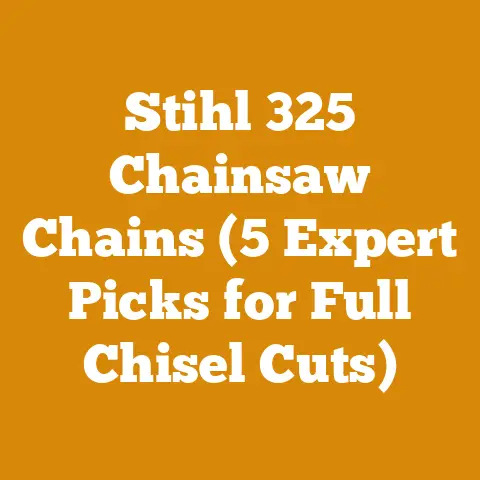Oregon Chain Identification Chart (5 Key Specs Every Logger Knows)
Isn’t it strange how something as seemingly simple as a chain can be the key to unlocking the potential of a powerful chainsaw?
You might think all chains are created equal, but trust me, after years of felling trees and processing timber, I’ve learned that understanding the nuances of chainsaw chain identification, particularly using an Oregon chain identification chart, is absolutely crucial.
It can be the difference between a productive day in the woods and a frustrating, potentially dangerous, experience.
Decoding the Steel Serpent: An In-Depth Look at Oregon Chain Identification
The world of chainsaw chains can feel overwhelming at first.
There are so many different types, each designed for specific applications.
As a logger and wood processor for over two decades, I’ve come to rely heavily on understanding the Oregon chain identification chart.
It’s my go-to resource for selecting the right chain for the job, ensuring optimal performance and safety.
Why Chain Identification Matters: My Close Call
I remember one particularly harrowing experience early in my career.
I was working on a large-scale logging project, and in a rush, I grabbed what I thought was the correct chain for my chainsaw.
Turns out, I was wrong.
The chain was designed for a smaller saw and softer wood.
Mid-cut, the chain snapped, sending the chainsaw kicking back violently.
I narrowly avoided serious injury, but it was a harsh lesson learned.
That day, I vowed to always double-check my chain identification before starting any project.
The 5 Key Specs Every Logger Knows (and You Should Too!)
The Oregon chain identification chart focuses on five critical specifications.
Mastering these will transform you from a novice to a knowledgeable user, ensuring you’re always equipped with the right chain for the task.
1. Pitch: The Rhythm of the Cut
Pitch refers to the distance between any three consecutive rivets on the chain, divided by two.
It’s measured in inches and usually found stamped on the drive link of the chain.
Common pitches include .325″, 3/8″ (0.375″), and .404″.
- .325″ Pitch: Ideal for smaller chainsaws used for limbing, pruning, and light firewood cutting.
They offer a good balance of speed and control. - 3/8″ (0.375″) Pitch: The most common pitch size, suitable for a wide range of chainsaws and applications, including felling medium-sized trees and preparing firewood.
- .404″ Pitch: Used primarily on larger, more powerful chainsaws designed for heavy-duty logging and felling large trees.
They offer aggressive cutting but require more power.
My Experience: I’ve found that using the wrong pitch can lead to premature chain wear, reduced cutting efficiency, and even damage to the chainsaw’s sprocket.
Always match the chain pitch to the specifications of your chainsaw.
Practical Tip: Use a pitch gauge to accurately measure the pitch of your chain.
These gauges are inexpensive and readily available at most chainsaw supply stores.
2. Gauge: The Groove’s Grip
Gauge refers to the thickness of the drive link, the part of the chain that fits into the guide bar groove.
It’s measured in inches and is often stamped on the drive link along with the pitch.
Common gauges include .043″, .050″, .058″, and .063″.
- .043″ Gauge: Typically found on smaller chainsaws used for pruning and light-duty tasks.
- .050″ Gauge: A very common gauge size, suitable for a wide range of chainsaws and applications.
- .058″ Gauge: Often used on larger chainsaws designed for more demanding tasks.
- .063″ Gauge: Primarily found on professional logging chainsaws used for felling large trees.
My Insight: Using a chain with the wrong gauge can be dangerous.
If the gauge is too small, the chain will be loose in the guide bar groove, leading to excessive vibration and potential derailment.
If the gauge is too large, the chain won’t fit in the groove at all.
Real-World Example: I once saw a logger try to force a .063″ gauge chain onto a guide bar designed for a .050″ gauge chain.
The result was a damaged guide bar and a useless chain.
Always ensure the chain gauge matches the guide bar groove.
3. Drive Link Count: The Chain’s Length
The drive link count refers to the total number of drive links in the chain.
This determines the length of the chain and must match the length of the guide bar.
How to Determine Drive Link Count: You can either count the drive links manually or consult the guide bar, which usually has the recommended drive link count stamped on it.
Why It Matters: Using a chain with the wrong drive link count will prevent it from fitting properly on the guide bar.
If the chain is too short, it won’t reach around the guide bar.
If the chain is too long, it will be loose and prone to derailment.
My Recommendation: Always double-check the drive link count before installing a new chain.
I keep a small notebook where I record the drive link count for each of my chainsaws.
This saves me time and prevents errors.
Quick Tip: If you’re unsure of the drive link count, bring your guide bar to a chainsaw supply store.
The staff can help you determine the correct count and select the appropriate chain.
4. Cutter Type: The Teeth That Bite
The cutter type refers to the shape and design of the cutting teeth on the chain.
Different cutter types are designed for different applications and wood types.
Common cutter types include:
- Chisel Cutters: These have square corners and are very aggressive, ideal for felling clean wood.
- Semi-Chisel Cutters: These have rounded corners and are more forgiving than chisel cutters, suitable for a wider range of wood types, including dirty or frozen wood.
- Micro-Chisel Cutters: These have small, rounded corners and are designed for smaller chainsaws used for limbing and pruning.
- Chipper Cutters: These have rounded cutters and are very durable, ideal for cutting dirty or abrasive wood.
My Preference: I primarily use semi-chisel cutters because they offer a good balance of cutting speed and durability.
They’re also less prone to damage from hitting dirt or rocks.
Case Study: I once worked on a project where we were felling trees in a sandy area.
The chisel cutters on my chain were constantly getting dull, requiring frequent sharpening.
I switched to chipper cutters, and the problem was solved.
The chipper cutters were much more resistant to abrasion, allowing me to work more efficiently.
Pro Tip: Consider the type of wood you’ll be cutting when selecting a cutter type.
For clean, softwood, chisel cutters are a good choice.
For dirty, hardwood, semi-chisel or chipper cutters are better.
5. Safety Features: Protecting Yourself
Modern chainsaw chains often incorporate safety features designed to reduce the risk of kickback.
These features include:
- Guard Links: These are raised links placed in front of the cutters to help prevent the chain from digging into the wood too deeply.
- Bumper Drive Links: These are drive links with a raised bumper that helps to reduce the aggressiveness of the chain.
My Stance on Safety: I always recommend using chains with safety features, especially for beginners.
While they may slightly reduce cutting speed, the added safety is well worth the trade-off.
Personal Anecdote: I’ve seen firsthand the devastating consequences of kickback.
One of my colleagues was seriously injured when his chainsaw kicked back and struck him in the face.
Fortunately, he was wearing a face shield, which prevented even more serious injury.
Safety First: Always wear appropriate safety gear, including a helmet, face shield, hearing protection, gloves, and chaps, when operating a chainsaw.
Now that you understand the five key specs, let’s take a closer look at how to use the Oregon chain identification chart.
- Locate the Chart: You can find the Oregon chain identification chart on the Oregon website or in most chainsaw supply catalogs.
- Identify the Pitch and Gauge: These are usually stamped on the drive link of your chain.
- Determine the Drive Link Count: Count the drive links or consult your guide bar.
- Choose the Cutter Type: Consider the type of wood you’ll be cutting and your desired level of aggressiveness.
- Select Safety Features: If you’re a beginner or working in a high-risk environment, choose a chain with safety features.
- Cross-Reference with the Chart: Use the chart to find the Oregon chain model number that matches your specifications.
Example: Let’s say you have a chain with a .325″ pitch, .050″ gauge, 68 drive links, semi-chisel cutters, and guard links.
Using the Oregon chain identification chart, you would find that the corresponding Oregon chain model number is 20LGX068G.
Beyond the Basics: Advanced Chain Selection
Once you’ve mastered the basics of chain identification, you can start to explore more advanced concepts, such as:
- Chain Sharpening: Properly sharpening your chain is essential for maintaining optimal performance and safety.
Learn how to use a file or chainsaw sharpener to keep your chain in top condition. - Chain Maintenance: Regularly clean and lubricate your chain to extend its lifespan.
- Specialty Chains: Explore specialty chains designed for specific applications, such as ripping chains for milling lumber or skip chains for felling large trees.
My Sharpening Ritual: I sharpen my chains after every tank of gas.
This keeps them cutting efficiently and reduces the strain on my chainsaw.
Chain Oil is Key: Always use high-quality chain oil to lubricate your chain.
This reduces friction and prevents premature wear.
Troubleshooting Common Chain Problems
Even with proper chain identification and maintenance, you may encounter problems from time to time.
Here are some common issues and how to troubleshoot them:
- Chain Dullness: If your chain is cutting slowly or not at all, it’s likely dull.
Sharpen the chain or replace it if necessary. - Chain Derailment: If your chain keeps coming off the guide bar, it could be due to a loose chain, a worn guide bar, or a damaged chain.
Tighten the chain, replace the guide bar, or replace the chain. - Chain Breakage: If your chain breaks, it could be due to a worn chain, a damaged chain, or excessive force.
Replace the chain and inspect your chainsaw for any damage.
My Go-To Solution: For minor chain derailments, I usually just tighten the chain tension.
For more serious problems, I replace the chain and inspect the guide bar for wear.
Prevention is Better Than Cure: Regularly inspect your chain for wear and damage.
Replace it before it breaks or causes other problems.
The Future of Chain Technology
The chainsaw chain industry is constantly evolving, with new technologies and innovations being introduced all the time.
Some of the latest developments include:
- Low-Vibration Chains: These chains are designed to reduce vibration, making them more comfortable to use and reducing the risk of fatigue.
- Low-Kickback Chains: These chains incorporate advanced safety features to further reduce the risk of kickback.
- Diamond Chains: These chains are coated with diamonds, making them extremely durable and capable of cutting through even the hardest materials.
My Prediction: I believe that future chainsaw chains will be even safer, more efficient, and more durable.
They will also be more environmentally friendly, with features such as reduced oil consumption and biodegradable lubricants.
Stay Informed: Keep up with the latest developments in chainsaw chain technology by reading industry publications and attending trade shows.
Oregon Chain Identification Chart: A Global Perspective
While the Oregon chain identification chart is widely used in North America, it’s also recognized and utilized by loggers and wood processors around the world.
However, it’s important to be aware of regional variations and differences in standards.
My International Experience: I’ve worked on logging projects in several different countries, and I’ve found that the Oregon chain identification chart is generally accepted as a reliable reference.
However, it’s always a good idea to check with local suppliers and experts to ensure you’re using the correct chain for your specific needs.
Global Standards: Be aware of different safety standards and regulations in different countries.
Some countries may have stricter requirements for chainsaw operation and chain safety.
The Environmental Impact of Chain Selection
Choosing the right chainsaw chain can also have a positive impact on the environment.
By using a chain that is appropriate for the task, you can reduce fuel consumption, emissions, and noise pollution.
My Commitment to Sustainability: I’m committed to using sustainable logging practices and minimizing my environmental impact.
This includes choosing chainsaw chains that are efficient and environmentally friendly.
Eco-Friendly Options: Consider using biodegradable chain oil and choosing chains with low-vibration features to reduce fatigue and improve efficiency.
Conclusion: Mastering the Chain for a Safer, More Productive Future
Understanding the Oregon chain identification chart is an essential skill for any logger, wood processor, or homeowner who uses a chainsaw.
By mastering the five key specs – pitch, gauge, drive link count, cutter type, and safety features – you can select the right chain for the job, ensuring optimal performance, safety, and efficiency.
My Final Thought: Don’t underestimate the importance of chain identification.
It’s a small detail that can make a big difference in your safety and productivity.
Take the time to learn the basics, and you’ll be well on your way to becoming a chainsaw expert.
Next Steps:
- Download the Oregon chain identification chart from the Oregon website.
- Inspect your chainsaw chains and identify their specifications.
- Practice using the chart to find the correct chain for your needs.
- Sharpen your chains regularly and maintain them properly.
- Always wear appropriate safety gear when operating a chainsaw.
By following these steps, you can ensure a safer, more productive, and more enjoyable experience with your chainsaw.
Now go forth and conquer those logs!






